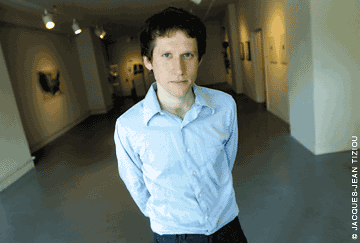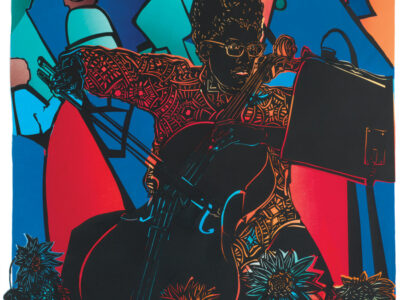A conversation with Slought director Aaron Levy

Go to the Slought Foundation’s website (www.slought.org), click on the calendar, and look at some of the items that pop up:
• “Sun Ra Meets Napoleon,” an exhibition that “playfully juxtaposes historical materials pertaining to ancient Egypt and the continual inspiration and relevance of Egyptology from the time of Bonaparte to that of Sun Ra.”
• “Architecture Against Death,” an installation by architects Arakawa + Gins that “provides directions for architectural procedure invention and assembly, and encourages … architectural bodies and the transhuman.”
• “Is an organization an altruistic art-form?” a public conversation with Dr. Susan Stewart (the Donald Regan Professor of English at Penn) and Dr. Michéle Richman (associate professor of French) on the future of the arts organization, the organization itself as an art form, and altruism in America.
That’s just a surface-scratch. Over the last two years, operating on a shoestring budget in a converted storefront at 4017 Walnut St., Slought has been quietly providing a heady mix of art and thought that crosses disciplines and genres: from architecture to jazz to film and poetry, in the form of exhibitions, discussions, concerts, and books.
Slought is the brainchild of several men: executive director Aaron Levy C’99 GGS’03 GGS’05; senior curator (and Penn English professor) Jean-Michel Rabaté; and senior curator (and Pennsylvania Academy of the Fine Arts professor) Osvaldo Romberg. But since the lightbulb for the Slought project came on when Levy was working as a programmer at the Kelly Writers House, it’s not surprising that Dr. Al Filreis, the Kelly Professor of English and faculty director of the Writers House, was present at the creation.
Slought has a “distinctively pedagogical or discursive or didactic orientation,” says Levy, who belongs in the Talker’s Hall of Fame, Academic Division. (His unedited answers bring to mind a fugue, full of swirling subordinate clauses and multiple, nuanced variations on a given theme.) “We’re taking advantage of the discursivity that’s the hallmark of a university or a higher kind of cultural organization, and trying to kind of integrate that or invigorate contemporary art with that in mind.”
Levy recently discoursed with Gazette senior editor Samuel Hughes about all things Slought.
Your mission statement says that “Slought’s curatorial practices resist the market-driven orientation and permanence of today’s institutions.” What are the pros and cons of that philosophy?
We’re interested in returning to the idea of a cultural institution which would simultaneously serve as a space for provocation and stimulation as well as enjoyment. And yet, achieving these sorts of ends—they need not be dismissed as mutually exclusive!—requires a degree of curatorial independence. I quite frankly don’t understand how the blockbuster exhibitions so prevalent today serve any of the educational goals the cultural establishment always prides itself on achieving. Against the tendency today to view culture as mere entertainment or as tourism, in which accessibility and attendance are of greatest importance, I suppose at Slought we view the critical process as a source of enjoyment in itself.
To return to your question, though: institutional permanence requires resources that are wholly beyond the scope of this project! We’re not necessarily interested in building a permanent collection or a stagnant institution. Why must cultural organizations always aspire toward permanence and sustainability? Why are issues such as institutional relevance or usefulness treated as secondary concerns? So I would argue that Slought is interested in promoting a different cultural landscape altogether, which is to say a new culture of temporality and non-permanence.
How are you making ends meet?
I wish I could tell you that it’s easy—but it’s not. It’s among the most difficult and humbling aspects of this organization in a society consumed by profit. The reality is that organizations such as ours are as fragile as ever. It’s also important to remember that we have a fantastic community of respected contemporary artists and theorists that are a backbone to the organization. Although their generosity doesn’t assume monetary form, their enthusiasm to participate in and embrace this evolving organization makes our projects possible.
The nearly 40 initiatives we organize each academic semester, from major exhibitions to trade publications and live events, are possible because of a stubborn resolve and determination on our part—the entire staff at Slought Foundation is unsalaried. They are also possible because of the beneficence of individuals who have learned to appreciate and support our programming.
What was Jean-Michel Rabaté’s role in getting Slought started?
This semester, we’re co-teaching a University graduate course on contemporary art from a curatorial and critical standpoint. It’s a lively course that meets here at Slought. My first encounter with Jean-Michel, however, was in an undergraduate class on theory at Penn—I believe we were reading Ezra Pound’s Guide to Kulchur at the time—and after that as my undergraduate mentor. In later years, our relationship flourished as we organized numerous symposia and an event series on theory around the University, and while I was resident fellow at Writers House organizing events in the poetry community. One of those symposia focused on the work of a respected international artist, Osvaldo Romberg, who subsequently became a founding member and senior curator at Slought. Slought became the natural outgrowth of those types of collaborations.
We occasionally hear questions such as, “Isn’t it odd to work together across generations and disciplines?” This of course catches us by surprise, since that’s precisely the reason we’re in this project! And it’s precisely this idea of interdisciplinarity and egalitarianism that is lacking in other organizations.
It sounds like the ideal university relationship.
I suppose I would turn the question around: Why is it so difficult to find other organizations today that are willing to engage in discursive or interdisciplinary or cross-generational projects? For Slought, an engaged orientation is crucial to our organization. Our initiatives unfold over time as a result of this engagement, resulting in an organization that is constantly evolving and not predetermined. I’m defining success here as a situation in which our organization and our audiences become structurally dependent upon each other.
On a similar note, I do think that organizations need to treat artistic practices and audiences as something more than markets to be managed and manipulated for accessibility and attendance. As a society, we need to move beyond the romantic notion that exposure to any cultural practice or institution is inherently redemptive and rewarding.
Philadelphia is a somewhat intellectually conservative city. I would think the future here would be difficult unless you can capture the imagination of a certain segment.
You know, Marcel Duchamp (whose work can be viewed at the Philadelphia Museum of Art) famously questioned the purpose of decorative practices, or what he termed “retinal art,” preferring instead the “non-retinal beauty of grey matter.” Duchamp’s comments are as applicable now as they were then. At the same time, the conservative climate in Philadelphia has been an empowering and enabling factor for us that has required us to hone our methodologies.
A recent article in The Philadelphia Inquirer quoted me as saying something like: “We’re experimenting. You could think of this as a laboratory.” We are indeed a laboratory in the curatorial sense, but we are also a laboratory in that we are constantly learning from our audiences. Slought Foundation is located along the 40th street corridor—not in Chelsea in New York, and not in Old City in Philadelphia—because we are interested in attracting a diverse constituency and cultivating a type of audience that Philadelphia has not previously known. And I want to believe that our audience respects the fact that our curatorial orientation does not cater exclusively to any single constituency.
Some of Slought’s projects, like Cities Without Citizens [a book of essays co-edited by Levy and Eduardo Cadava], address issues that fall under Penn’s Urban Agenda.
The book participates in and contributes to a variety of discussions. These wide-ranging discussions address topics such as disaster relief housing in Africa, prison reform in America, and the construction of new cities in Japan. Although our work doesn’t address Philadelphia in any contemporary sense, I imagine the ideas found within might be constructive to those seeking to reinvigorate the urban landscape.
The book was actually co-published with the Rosenbach Museum and Library, in conjunction with an exhibition I organized there as 2003 artist-in-residence. Some of the questions that the project posed included: “What is a city? What would it mean to establish the borders of a city, to define and delimit it in order to confer an identity upon it? What is citizenship and how is it established or lost, asserted or taken away?” The book also featured essays and documents engaging contemporary issues of citizenship, human rights, and the architecture of cities.
Right now I’m working on a similar exhibition, “The Revolt of the Bees,” which playfully engages beehive metaphors in the rare book and manuscript collections of the University. Particular emphasis is being given to those books which speak to social organization and governance, and the lessons extracted from these books are put in the service of envisioning the archive of the future.
How do you compare to other Penn-related or Penn-supported arts organizations like the ICA?
Beyond merely coexisting with area organizations, our respective cultural orientations and diverse viewpoints complement each other. However, the situation I have to deal with on a daily basis is: Is there a future for organizations such as ours within the cultural establishment? And how can larger institutions and foundations create a more hospitable climate in the future? I suppose the question I would in turn pose is this: What do you consider the role of a cultural institution to be, and which institutions embody those practices and aspirations, and need your support?




